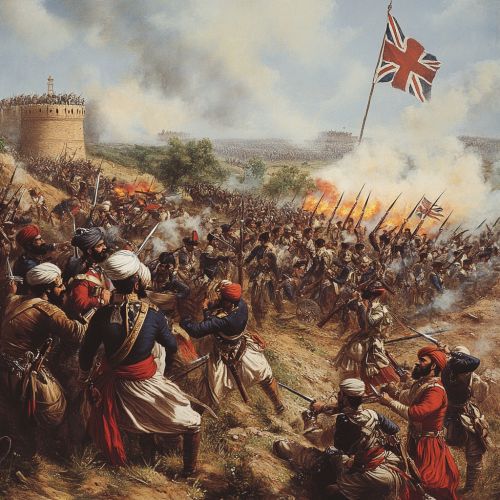Battle of Gujrat: Difference between revisions
(Created page with "== Battle of Gujrat == The Battle of Gujrat was a significant military engagement that took place on February 21, 1849, during the Second Anglo-Sikh War. This battle marked the decisive defeat of the Sikh Empire by the forces of the British East India Company, leading to the annexation of the Punjab region into British India. <div class='only_on_desktop image-preview'><div class='image-preview-loader'></div></div><div class='only_on_mobile image-preview'><div class='im...") |
No edit summary |
||
| Line 3: | Line 3: | ||
The Battle of Gujrat was a significant military engagement that took place on February 21, 1849, during the Second Anglo-Sikh War. This battle marked the decisive defeat of the Sikh Empire by the forces of the British East India Company, leading to the annexation of the Punjab region into British India. | The Battle of Gujrat was a significant military engagement that took place on February 21, 1849, during the Second Anglo-Sikh War. This battle marked the decisive defeat of the Sikh Empire by the forces of the British East India Company, leading to the annexation of the Punjab region into British India. | ||
[[Image:Detail-97511.jpg|thumb|center|Depiction of the Battle of Gujrat showing British and Sikh forces in combat.|class=only_on_mobile]] | |||
[[Image:Detail-97512.jpg|thumb|center|Depiction of the Battle of Gujrat showing British and Sikh forces in combat.|class=only_on_desktop]] | |||
=== Background === | === Background === | ||
Latest revision as of 11:14, 7 August 2024
Battle of Gujrat
The Battle of Gujrat was a significant military engagement that took place on February 21, 1849, during the Second Anglo-Sikh War. This battle marked the decisive defeat of the Sikh Empire by the forces of the British East India Company, leading to the annexation of the Punjab region into British India.


Background
The Second Anglo-Sikh War was a result of the deteriorating relations between the Sikh Empire and the British East India Company following the First Anglo-Sikh War (1845-1846). The Treaty of Lahore, which concluded the first conflict, imposed harsh terms on the Sikh Empire, including the cession of valuable territories and the reduction of the Sikh army. Tensions remained high, and by 1848, a series of rebellions and political machinations led to renewed hostilities.
The British, under the command of General Sir Hugh Gough, sought to quell the Sikh resistance and secure their control over the Punjab region. The Sikh forces, led by Sher Singh Attariwalla, were determined to resist British domination and restore their sovereignty.
Prelude to the Battle
In the months leading up to the Battle of Gujrat, both sides engaged in a series of skirmishes and maneuvers. The British forces, despite suffering setbacks in earlier engagements such as the Battle of Chillianwala, regrouped and reinforced their positions. General Gough, known for his aggressive tactics, planned a decisive confrontation to crush the remaining Sikh resistance.
The Sikh army, though weakened, was still a formidable force. They had fortified their positions around the town of Gujrat, a strategic location in the Punjab region. The Sikh forces were well-equipped with artillery and had the advantage of defensive preparations.
The Battle
The Battle of Gujrat commenced on the morning of February 21, 1849. General Gough deployed his forces in a coordinated assault, utilizing infantry, cavalry, and artillery. The British artillery played a crucial role in the battle, bombarding the Sikh positions with relentless precision.
The Sikh forces, despite their valiant efforts, were unable to withstand the superior firepower and disciplined maneuvers of the British troops. The battle raged for several hours, with intense fighting on both sides. The British cavalry, led by Brigadier General Sir Joseph Thackwell, executed flanking maneuvers that further destabilized the Sikh defenses.
By the afternoon, the Sikh lines began to crumble under the sustained pressure. The British forces breached the Sikh fortifications and engaged in close-quarters combat. The Sikh soldiers, facing overwhelming odds, fought bravely but were eventually forced to retreat.
Aftermath
The Battle of Gujrat was a decisive victory for the British East India Company. The defeat of the Sikh forces marked the end of organized resistance in the Punjab region. In the weeks following the battle, the British pursued the remnants of the Sikh army, capturing key leaders and securing control over the territory.
The annexation of Punjab was formally declared on March 29, 1849, by Lord Dalhousie, the Governor-General of India. The Sikh Empire was dissolved, and the region was incorporated into British India. The defeat had significant political and cultural ramifications, leading to the disbandment of the Sikh Khalsa Army and the exile of Maharaja Duleep Singh, the last ruler of the Sikh Empire.
Legacy
The Battle of Gujrat is remembered as a pivotal moment in the history of British India and the Sikh community. It marked the end of Sikh sovereignty and the beginning of direct British rule in the Punjab region. The battle demonstrated the effectiveness of British military tactics and the importance of artillery in modern warfare.
The annexation of Punjab had long-lasting effects on the region's political and social landscape. The British administration implemented various reforms and infrastructure projects, which had both positive and negative impacts on the local population. The legacy of the battle and the subsequent British rule continue to influence the cultural and historical narratives of the region.
